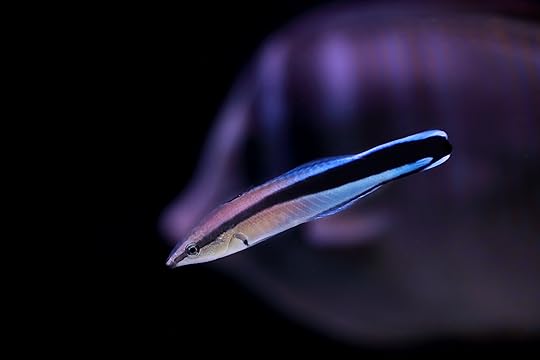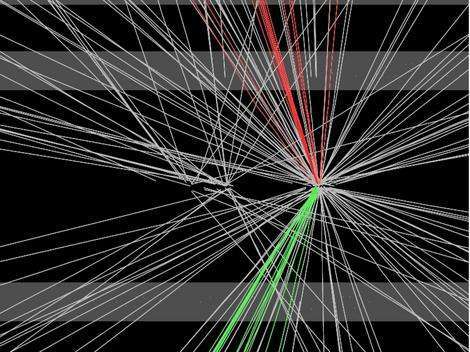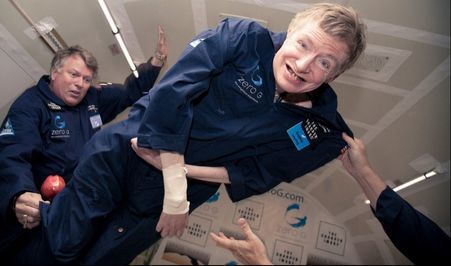Michael J. Behe's Blog, page 515
March 4, 2019
Your inner fish? Did fish really show self-awareness?

Yes, if you believe the mirror test proves it:
The bluestreak cleaner wrasse has passed the famous mirror test for self-recognition (originally intended for primate apes and monkeys).
According to a recent paper (open access), three out of four fish tested by researchers from Osaka City University in Japan were able to learn to identify the object in a mirror as their own images. But what does that mean?
When chimpanzees, dolphins, elephants, and magpies passed the test1, researchers theorized that these animals, recognized as intelligent, were demonstrating a concept of “self.” Now they are not so sure. Is the cleaner wrasse, which grooms other fish for parasites, really self-aware? Are fish much smarter than we think? More.
But what if the whole question is founded on a mistake about the nature of the mirror test?
Overall, it’s a curious outcome for the mirror test. Those who felt reassured by close kinship with chimpanzees reacted quite differently when offered close kinship with fish.
Follow UD News at Twitter!
See also: How is human language different from animal signals? What do we need from language that we cannot get from signals alone? (Michael Egnor)
Why only human beings speak: Language is a tool for abstract thinking—a necessary tool for abstraction—and humans are the only animals who think abstractly. (Michael Egnor)
and
Animal minds: In search of the minimal self
Copyright © 2019 Uncommon Descent . This Feed is for personal non-commercial use only. If you are not reading this material in your news aggregator, the site you are looking at is guilty of copyright infringement UNLESS EXPLICIT PERMISSION OTHERWISE HAS BEEN GIVEN. Please contact legal@uncommondescent.com so we can take legal action immediately.
Plugin by Taragana
Open access: UCal severs links with Elsevier/Big Pharma loves open access
 What’s hot? What’s not?/Niklas Bildhauer, Wikimedia
What’s hot? What’s not?/Niklas Bildhauer, WikimediaThe University of California has been promoting free access to publicly funded research:
The University of California has ended its subscription to journals published by Elsevier, citing a failure to reach an agreement that would lower fees and prioritize open access to its scholars’ work, the UC system announced yesterday (February 28). The decision to stop paying for access to Elsevier’s journals came after eight months of contract negotiations. Carolyn Wilke, “With No Open Access Deal, UC Breaks with Elsevier” at The Scientist
There are suggestions that other institutions will follow suit.
Imagine being so backward as to think that the public who funded the research should get to read what was funded without paying a fortune… Sure, maybe there’ll be some surprises. A few may think that sexual politics among dogs is not an important research topic compared to affordable prevention/treatment/cure for devastating tropical diseases. And now they know! Pandora’s box cubed…
Why does Big Pharma love open access publishing?
In a literature analysis, researchers found that the proportion of open-access papers published by 23 large drug companies, such as Pfizer and Roche, almost doubled between 2009 and 2016, and has overtaken the proportion of freely available papers published generally in medicine-related fields. The study was posted to the SocArXiv preprint server on 7 February1. …
Industry’s greater emphasis on green open access might also reflect a strategy of getting information out quickly, rather than worrying about publishing in high-profile journals. “They don’t need the imprimatur of prestigious journals,” Siler says. “They’re not playing the academic status game.” Matthew Warren, “Big pharma is embracing open-access publishing like never before” at Nature
No, Big Pharma is not playing the academic status game. But also, many of the people who might need the information would not have access to a university library that subscribes to expensive publications. How about people who are making decisions about cancer treatments who would like to find out if studies they have heard about were replicated?
Follow UD News at Twitter!
See also: A Science Journal’s Editors Resign En Masse Over Open Access Foot-Dragging
Pay wall for science articles: Yes or no?
and
How Unpaywall is opening up science
Copyright © 2019 Uncommon Descent . This Feed is for personal non-commercial use only. If you are not reading this material in your news aggregator, the site you are looking at is guilty of copyright infringement UNLESS EXPLICIT PERMISSION OTHERWISE HAS BEEN GIVEN. Please contact legal@uncommondescent.com so we can take legal action immediately.
Plugin by Taragana
Researchers: First animal cell was not simple; it could “transdifferentiate”
 structure of an animal cell/royroydeb (CC BY-SA 4.0)
structure of an animal cell/royroydeb (CC BY-SA 4.0)From Nature: “Transdifferentiation is the conversion of a cell type present in one tissue or organ into a cell type from another tissue or organ without going through a pluripotent cell state. Transdifferentiation between some cell types can occur naturally in response to injury and can be induced experimentally.”
From the abstract of an interesting preprint:
… these analyses offer no support for the homology of sponge choanocytes and choanoflagellates, nor for the view that the first multicellular animals were simple balls of cells with limited capacity to differentiate. Instead, our results are consistent with the first animal cell being able to transition between multiple states in a manner similar to modern transdifferentiating and stem cells.Shunsuke Sogabe, William L. Hatleberg, Kevin M. Kocot, Tahsha E. Say, Daniel Stoupin, Kathrein E. Roper, Selene L. Fernandez-Valverde, Sandie M. Degnan and Bernard M. Degnan, “Pluripotency and the origin of animal multicellularity” at bioarxiv
Follow UD News at Twitter!
Before you go: “Interspecies communication” strategy between gut bacteria and mammalian hosts’ genes described
Researchers: Cells Have A Repair Crew That Fixes Local Leaks
Researchers: How The Immune System “Thinks”
Researcher: Mathematics Sheds Light On “Unfathomably Complex” Cellular Thinking
How do cells in the body know where they are supposed to be?
Researchers A Kill Cancer Code Is Embedded in Every Cell
How Do Cells Interpret The “Dizzying” Communications Pathways In Multicellular Life Forms?
and
Cell atlases reveal extreme complexity at biology’s frontiers
Copyright © 2019 Uncommon Descent . This Feed is for personal non-commercial use only. If you are not reading this material in your news aggregator, the site you are looking at is guilty of copyright infringement UNLESS EXPLICIT PERMISSION OTHERWISE HAS BEEN GIVEN. Please contact legal@uncommondescent.com so we can take legal action immediately.
Plugin by Taragana
We’ll find those “sparticles” if we have to dig up the universe!
 collision of particles/ATLAS team (2011)
collision of particles/ATLAS team (2011)An astrophysicist explains why we “gotta” go beyond the Standard Model of the universe:
The governing theory of particle physics explains everything about the subatomic world … except for the parts that it doesn’t. And unfortunately, there aren’t a lot of flattering adjectives that can be applied to the so-called Standard Model. Built up bit by bit over the course of decades, this theory of fundamental physics is best described as ungainly, hodgepodge and MacGyver-ed together with pieces of string and chewing gum. Still, it’s an incredibly powerful model that accurately predicts a tremendous variety of interactions and processes. Paul Sutter, “Where Are All the ‘Sparticles’ That Could Explain What’s Wrong with the Universe?” at LiveScience
In short, the model works just fine but astrophysicists don’t like it. Many have made clear that that is because it looks so much like fine-tuning of the universe.
The proposition is simple, when we get right down to it: Even if a model that implies fine-tuning is “incredibly powerful” and “predicts a tremendous variety of interactions and processes” it must be rejected in favor of costly, futile, or even crackpot efforts to find something else that people can be got to believe. One recent search that appears to have come up dry is for “Long-lived supersymmetric particles, sometimes called sparticles for short” (Sutter).
And “sparticles”? They are a component of some of the claims for string theory/supersymmetry, aimed at birthing a multiverse, whether real or imaginary or effacing the distinction between the two:
Alan Barr: The theory of ‘Supersymmetry’ extends the Standard Model, and solves many of its problems. The clearest prediction of this grander theory is that for every known type of particle there should be a Supersymmetric partner particle, known as a ‘particle’… Our team has looked for the signs of particular sparticles – the so-called ‘squarks’ and ‘gluinos’ – from the data recorded by ATLAS last year. Our results show is that if these sparticles do exist, they must be heavier than previously thought. They must weigh more than about 800 protons – otherwise we would have seen them already. (2011) Pete Wilton, “The search for sparticles” at Phys.org
And how’s the search coming in 2019? According to Sutter:
Simply put, we can’t find any partner particles. Zero. Zilch. Nada. No hints of supersymmetry have appeared in the world’s most powerful collider, where particles are zipped around a circular contraption at near light-speed before colliding with each other, which sometimes results in the production of exotic new particles. It doesn’t necessarily mean that supersymmetry is wrong, per se, but all the simplest models have now been ruled out. Is it time to abandon supersymmetry? Maybe, but there might be a Hail Mary: long-lived particles. Paul Sutter, “Where Are All the ‘Sparticles’ That Could Explain What’s Wrong with the Universe?” at LiveScience
Calling this stuff science does not transform it into a rational endeavor. A rational endeavor includes more deep and more honest analysis of why the Standard Model is so widely hated even if it may well be correct.
Note: Hail Mary is one of the most-loved prayers of the Catholic Church. Saying it daily helps many people with crushing problems. But, to clarify, its proponents do not claim it is science and would rather its name was not used in these contexts.
Follow UD News at Twitter!
See also: How did Stephen Hawking get to be “world’s smartest scientist”? Top People need a multiverse. The rewards go to those who can conjure one. Hawking did his best within the boundaries of science and is to be commended for going no further. We have heard and will hear plenty from those who show no such qualms.
What becomes of science when the evidence does not matter?
and
Supersymmetry A Beautiful Idea, Lacking Only Evidence “Strictly speaking, Susy can never be formally disproved. It can always be tweaked so that sparticles appear only at energies that are just out of reach of the best existing colliders.”
Copyright © 2019 Uncommon Descent . This Feed is for personal non-commercial use only. If you are not reading this material in your news aggregator, the site you are looking at is guilty of copyright infringement UNLESS EXPLICIT PERMISSION OTHERWISE HAS BEEN GIVEN. Please contact legal@uncommondescent.com so we can take legal action immediately.
Plugin by Taragana
How did Stephen Hawking get to be “world’s smartest scientist”?
 Stephen Hawking (1942 – 2018)/
Stephen Hawking (1942 – 2018)/Steve Boxall, steveboxall.com
Which is pretty much how popular media treated him:
Yes, he was brilliant. And who could not be inspired by his rising above such a debilitating physical condition that left him wheelchair-bound for decades? But there are other factors to consider.
Many underestimate the place that science holds in today’s cultural backdrop. In pre-modern Christendom, the ultimate statement of authority was “Thus saith the Lord.” Today, the closest statement with that sort of gravitas is “the science is settled,” despite how often that claim is misused to stifle debate and advance ideologies.
And also, Stephen Hawking didn’t stay in his lane. He was a scientist, but in each of his books and nearly all of his media appearances, he ventured into philosophy, masking metaphysical observations and proclamations in language of scientific certainty. John Stonestreet, “Scientism vs. Revelation & the Limits of Knowledge” at Salvo
Yes, he was careful to do science and leave the crackpot cosmology for the long-anticipated dessert. The media loved it because gullible notables loved it.
The comparatively unknown Sabine Hossenfelder is a much more reliable guide to what makes sense and nonsense in theoretical physics. But that’s why she is a comparatively unknown freelance physicist.
Top People need a multiverse. The rewards go to those who can conjure one. Hawking did his best within the boundaries of science and is to be commended for going no further. We have heard and will hear plenty from those who show no such qualms.
Something to watch: Will Stephen Hawking still be compared to Einstein and Newton 25 years from now?
Follow UD News at Twitter!
See also: Stephen Hawking’s final paper, just released, tacked the information paradox
and
The multiverse is science’s assisted suicide
Copyright © 2019 Uncommon Descent . This Feed is for personal non-commercial use only. If you are not reading this material in your news aggregator, the site you are looking at is guilty of copyright infringement UNLESS EXPLICIT PERMISSION OTHERWISE HAS BEEN GIVEN. Please contact legal@uncommondescent.com so we can take legal action immediately.
Plugin by Taragana
March 3, 2019
French author muses on why Darwinism never dies
![Flight From the Absolute: Cynical Observations on the Postmodern West. Volume II by [Gosselin, Paul]](https://i.gr-assets.com/images/S/compressed.photo.goodreads.com/hostedimages/1551688785i/27150714.jpg) In an essay on Paul Gosselin ’s Flight from the Absolute: Cynical Observations on the Postmodern West, Volume II, we are told,
In an essay on Paul Gosselin ’s Flight from the Absolute: Cynical Observations on the Postmodern West, Volume II, we are told,
Over two and a half decades have passed since Phillip E. Johnson kick-started the intelligent design (ID) movement in America with the publication of his path-breaking book, Darwin on Trial (1991). In this book, he exposed the numerous flaws in Darwinian evolution and the near irrationality of those who continued to defend it in the face of mounting evidence against it. In the intervening years, two seemingly contradictory things have happened: the evidence against macro-evolution has continued to mount up; and the defenders of macro-evolution have gotten increasingly shrill and censorious, asserting more and more loudly the false claim that the evidence for Darwinism is overwhelming and
indisputable.
Quite right, and any number of other people have challenged Darwinism as well, from a variety of perspectives, eliciting only approved boilerplate in response. So it’s not actually about the ID guys, is it? It’s something else. Gosselin offers,
In Volume II, a stand-alone book that can be profitably read on its own, Gosselin zeroes in on the subject of evolution, presenting it as the origin myth of both modern and postmodern man and tracing its history and function as both an “ideologico-religious system” (118) and a “total and integrated scientific answer . . . for all aspects of reality” (217). By marshalling a vast yet carefully selected array of quotes from key writers on all sides of the evolution debate, Gosselin makes it clear that “the Darwinian revolution was more cultural and ideological than scientific” (84)…
It is in the interest of postmoderns, for whom absolute moral standards issuing from a creator God represents an obstacle to their own absolute self-expression (particularly in the realm of sexuality), to uphold the sacred aura that surrounds the Darwinian origins myth. That is why postmodern critics will question science’s role as ultimate arbiter of truth while leaving evolution itself unquestioned. Louis Markos, “The Aura of Science” at Touchstone
You can question pretty much anything but Darwinism. Markos details how much more difficult it is to dissent in the French environment Gosselin encounters in Canada than it would be in the United States, which may surprise some.
Hat tip: Heather Zeiger
See also: A Review Of Behe’s Darwin Devolves That Looks At What Behe Actually Says
Follow UD News at Twitter!
Copyright © 2019 Uncommon Descent . This Feed is for personal non-commercial use only. If you are not reading this material in your news aggregator, the site you are looking at is guilty of copyright infringement UNLESS EXPLICIT PERMISSION OTHERWISE HAS BEEN GIVEN. Please contact legal@uncommondescent.com so we can take legal action immediately.
Plugin by Taragana
Why Thomas Aquinas would like intelligent design research

Itfits in with an understanding of what differentiates life from non-life:
Living things, St. Thomas observed, differ from inanimate things in that living things act for their own perfection. By perfection, he meant that living things act to become more realized versions of their type. A squirrel seeks food, defends itself, has offspring, heals wounds, etc., all of which are essential to what it means to be a squirrel. A rock doesn’t do anything to make itself a better rock. It merely is what it is. Living things have immanent causation — causation that arises from within and tends to the betterment of the organism. Inanimate things have transeunt causation — causation that arises from without, and that acts on, and not by, the object itself. Transeunt causation does not tend to the betterment of the object.
In intelligent design science, we infer design by looking for evidence that the system under study acts in a way that betters itself or realizes a goal that improves it. This we call “specified complexity” which, I believe, is tantamount to inferring immanent causation. In archeology, we infer design by identifying an object as a part of a building or a tool or a sample of writing, rather than a random stone. Building or tool-making or writing are examples of immanent causation — acts of intelligent agents seeking to realize their nature. Intelligent agents seek shelter and make tools and express thoughts. Inanimate objects don’t. Michael Egnor, “What is intelligent design: A Thomistic perspective” at Evolution News and Science Today
It’s been fashionable for Thomistic philosophers to avoid harassment by claiming to oppose ID but their positions rarely seem to make any sense. And when they do, it so often sounds as if the Thomist would be happier as a naturalist (nature is all there is). It might be workplace issue, who knows?
Follow UD News at Twitter!
See also: How can mere products of nature have free will?
Does brain stimulation research challenge free will?
and
Is free will a dangerous myth?
Copyright © 2019 Uncommon Descent . This Feed is for personal non-commercial use only. If you are not reading this material in your news aggregator, the site you are looking at is guilty of copyright infringement UNLESS EXPLICIT PERMISSION OTHERWISE HAS BEEN GIVEN. Please contact legal@uncommondescent.com so we can take legal action immediately.
Plugin by Taragana
Fun: Scooby Doo and the Silly Skeptics
In “Scooby-Doo on Zombie Island,” the gang encounters real zombies and ghosts for the first time. But Fred explains away the evidence by appealing to increasingly absurd naturalistic explanations. In the end, even Fred recognizes that his explanations simply can’t account for the facts.
Atheists often call themselves “skeptics.” But when we consider the methodology they apply when questioning God’s existence, we find that the atheist’s methodology rules out all evidence for God’s existence even before considering what the evidence is.
In this video, David Wood uses some clips from “Scooby-Doo on Zombie Island” and some clips from his recent debate with Dr. Michael Shermer to show why it’s becoming impossible to take atheists seriously when they demand evidence for God’s existence.
See also: John Lennox vs. Peter Atkins: Can science explain everything?
Unbelievable? presenter Justin Brierley chairs a live dialogue between Oxford professors John LennoxJohn Lennox and Peter Atkins followed by audience Q&A.
Where Did The Laws Of Nature Come From?: Astrophysicist Hugh Ross vs Chemist Peter Atkins (2018)
and
Mathematician John Lennox Asks, Is Information Evidence Of Something Beyond Nature?
Copyright © 2019 Uncommon Descent . This Feed is for personal non-commercial use only. If you are not reading this material in your news aggregator, the site you are looking at is guilty of copyright infringement UNLESS EXPLICIT PERMISSION OTHERWISE HAS BEEN GIVEN. Please contact legal@uncommondescent.com so we can take legal action immediately.
Plugin by Taragana
If you need a benevolent god, look no further than Netflix
No sermons, no tithing, but…

Adam Nieri: AI can even heal miraculously, but there is a price to be paid:
In the first episode of Travelers season 3, we glimpse the show’s more philosophical perception of AI in the future. While waiting to give the order to take down MacLaren and his team, the director of the FBI (who knows about the travelers) listens to a story told by agent Joanne Yates (who will become more important later in the season). The Director (from the future) had been in contact with Yates. Speaking through her dying mother, the Director had relayed a message intended for the FBI director: “…tell him, the bargain he made that autumn morning was not with his god, but with me”. The Director is referring to a moment in which the director of the FBI was moments away from losing his only daughter to cancer. As he prepared for the worst, the Director spoke through the dying daughter and made a deal, “I will save her life, but there will come a day of reckoning.” And, just like that, her cancer was gone and she was healed. Adam Nieri, ““Travelers” Portrays AI As A Benevolent God” at Mind Matters
See also: Alita: Battle Angel (2019): A Mind Matters Review Adam Nieri: If you love anime and felt betrayed by the flop of Ghost, I would highly recommend Alita (Adam Nieri)
Copyright © 2019 Uncommon Descent . This Feed is for personal non-commercial use only. If you are not reading this material in your news aggregator, the site you are looking at is guilty of copyright infringement UNLESS EXPLICIT PERMISSION OTHERWISE HAS BEEN GIVEN. Please contact legal@uncommondescent.com so we can take legal action immediately.
Plugin by Taragana
Guy pretending to be atheist enrages real atheists
He thinks its okay to just mind his own business:
PROVIDENCE, RI—Casting serious doubt over his commitment, self-professed atheist Edward Horvath came under intense scrutiny Monday after sources revealed that despite ample opportunities, he has never once barged into local churches screaming that the parishioners are all “brainwashed fools.” “So-Called ‘Atheist’ Doesn’t Even Barge Into Churches Screaming ‘You’re All Brainwashed Fools’” at The Onion
Our old friend Darwinian evolutionary biologist Jerry Coyne was fretting recently over claims that new atheism is dying. P.Z. Myers has been holding forth on that subject.
The Onion has identified a possible cause: Lack of activism. Some of us are not sure how well Onionized activism would work for them.
If that’s the show, it’s already nearly over. The raging Woke are screaming about nearly everything now.
See also: The three living New Atheist figureheads deny that New Atheism is dead Not sure what the difference is between disappearing and diffusing “into the wider conversation.” Time will tell.
and
A shambolic atheist community faces some tough choices. In-fighting and scandal are tainting the brand
Follow UD News at Twitter!
Copyright © 2019 Uncommon Descent . This Feed is for personal non-commercial use only. If you are not reading this material in your news aggregator, the site you are looking at is guilty of copyright infringement UNLESS EXPLICIT PERMISSION OTHERWISE HAS BEEN GIVEN. Please contact legal@uncommondescent.com so we can take legal action immediately.
Plugin by Taragana
Michael J. Behe's Blog
- Michael J. Behe's profile
- 219 followers



